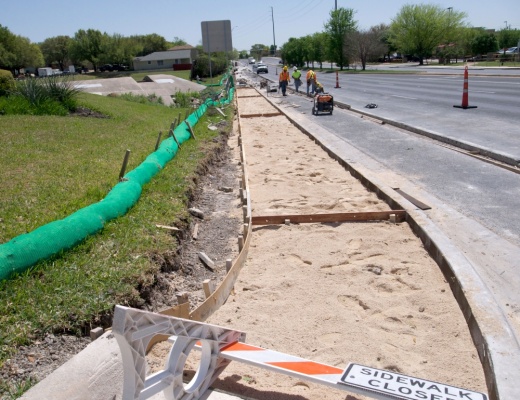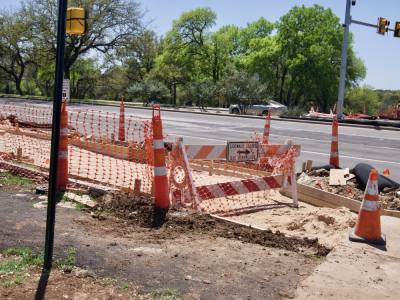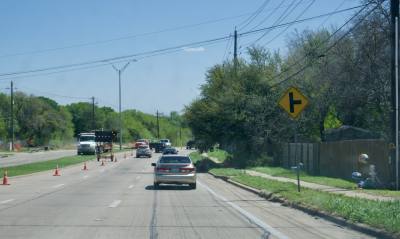“There technically are bike lanes, but I wouldn’t really call them bike lanes,” Acres said of her commute. “I wouldn’t even call them bike gutters.”
William Cannon is one of two multimillion-dollar transportation projects, along Slaughter Lane, that the city of Austin broke ground on in 2021 for a cost of $46.6 million and $74 million, respectively. The projects are part of the Austin Corridor Mobility Program, which received $482 million from the 2016 mobility bond for road, bike and pedestrian improvements.
“A lot of people we’ve talked to in the community see William Cannon and Slaughter Lane as very car-centric corridors,” said Kelly Buethe, a communications liaison with the corridor program office. “They have expressed that they don’t feel safe walking or biking along the corridors, and they want congestion improved.”
For Acres, crossing I-35 at both William Cannon Drive and Slaughter Lane is particularly difficult and improvements could benefit her commute.
“As you get to the intersection, the bike lanes just disappear,” Acres said. “The right turn lanes back up really far, because everyone wants to get on I-35. People in cars are fighting to try to get over and cut each other off, and it just spits you out into the middle of that.”
Making progress
Initial construction along William Cannon and Slaughter began in late 2021, and all major projects will be underway or complete by 2024. The first phase of work on the William Cannon corridor upgrades will be completed in May, while initial work on Slaughter will end in September. The next phase of construction on William Cannon will install new traffic signals and pedestrian crossing signals. William Cannon will also have new shared-use paths for cyclists and pedestrians, road widening to four lanes and a new bridge over Marble Creek Greenbelt.
Signals, crosswalks, shared-use paths and protected bike lanes on Slaughter are the next planned upgrades. Improving safety, reducing congestion
To determine infrastructure needs, the corridor program office studied crash data and traffic reports along the two roadways. For safety improvements, the office consulted the city’s Vision Zero program, an initiative to reduce the number of residents injured or killed by car crashes to zero.
Vision Zero data showed nearly 7,000 total reported crashes on the William Cannon and Slaughter from 2016-21, with over 80 involving pedestrians and nearly 40 involving cyclists.
Safety upgrades include adding Americans with Disabilities Act-compliant sidewalks, shared-use paths, more visible crosswalks and pedestrian crossing signals.
“For pedestrian safety, [crossing signals] are a no-brainer,” said Kara Kockelman, a transportation engineering professor at The University of Texas at Austin. “A lot of pedestrian deaths are mid-block. People do not want to walk all the way to a major intersection, especially on something like William Cannon, which is five lanes and has widely spaced intersections.”
To reduce traffic congestion, the corridor program office studied delay time at signalized intersections along the corridors during peak A.M. and P.M. hours.
The William Cannon corridor has 63 intersections, and the Slaughter corridor has 56. At more than 20 intersections studied, a 2017 report showed on average drivers saw delays of 2.5 minutes due to traffic signals.
“Traffic during the commute can be pretty annoying at any point,” said Greg Grimes, who commutes on William Cannon and Slaughter by car. “It’s just luck if you can make it without getting caught up in traffic.”
Building ‘complete communities’
The nine corridors slated for upgrades from the city’s $482 million corridor program were also evaluated with the aim of creating “complete communities,” a concept outlined in the city’s Imagine Austin comprehensive plan of 2012. According to the plan, these would provide amenities, transportation, services and opportunities that fulfill all residents’ retail, social and economic needs.
Other city programs such as Capital Metro’s Project Connect—the $7 billion transit plan approved by Austin voters in 2020—will tie in. Capital Metro is planning light-rail service and expanding the MetroRapid bus line in South Austin. The north-south Orange Line will be a new line with stops along William Cannon and Slaughter. The agency will expand MetroRapid Route 803, which currently runs from The Domain to Westgate Transit Center, farther south to Oak Hill and down Menchaca Road near Slaughter.
Buethe said a goal of the program is to connect communities to multiple modes of transportation.
“[The improvements] serve our community in a way that allows them to connect to their schools, their jobs and their health care,” Buethe said.










